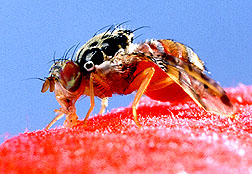Science Update
|
|
Company Gets License To Dye Fruit Flies
ARS has issued a license for its patented technology using a bait to trick fruit flies into eating a red dye that kills them once they are exposed to light. ARS issued an exclusive license to PhotoDye International, Inc., of Baltimore, Maryland. Scientists refined and tested the bait-dye product, SureDye, under cooperative research and development agreements with the company. The product has potential as an alternative to malathion for suppressing fly invasions such as the one by Mediterranean fruit flies last year in Florida. The dye also kills Mexican, Caribbean, carambola, and oriental fruit flies. It has long had Food and Drug Administration approval for drug and cosmetic uses. The bait doesn't attract honey bees, ladybugs, or other beneficial bugs. But its sugars, proteins, and other ingredients attract fruit flies and stimulate them to feed. The bait-dye mix has killed up to 100 percent of fruit flies in tests in citrus, mango, carambola, and other tropical and subtropical crops. Test sites have included California, Florida, Hawaii, and Texas, as well as Brazil, Guatemala, Mexico, Morocco, South Africa, and Surinam.
Robert Mangan, USDA-ARS Subtropical Agricultural Research Center, Weslaco, Texas; phone (956) 565-2647.
Steven Peck, USDA-ARS Tropical Fruit, Vegetable, and Ornamental Crop Research Laboratory, Hilo, Hawaii; phone (808) 959-4300.
Low-Phytic-Acid Corn Gets First License
In a couple of years, corn growers may be able to plant commercial hybrids with a trait that can cut water pollution while increasing the grain's nutritional value in poultry and pig feed. In February, ARS awarded the first license for its new patented corn, which is low in phytic acid. Abundant in regular corn, phytic acid is a form of phosphorus unusable by animals with one stomach, notably poultry and pigs. Most phosphorus in corn winds up in the animals' manure. Rain can carry the nutrient to waterways, and excess phosphorus promotes algae that can consume oxygen from the water to choke out fish and other aquatic organisms. Feed for one-stomached animals can be treated with enzymes to increase phosphorus intake. But low-phytic-acid (LPA) hybrids could be a less expensive, more sustainable strategy. An ARS scientist developed LPA corn as a result of natural gene mutation. In tests, using this corn in feed has reduced phosphorus loss to manure by 25 to 40 percent. To enable wide use of LPA corn, ARS is negotiating licenses with companies that produce hybrid corn seed. The first license was signed with Pioneer Hi-Bred International, Johnston, Iowa. Pioneer and other companies are breeding the trait into superior corn plants. Commercial hybrids may be released in a year or two. But that will happen only if the plants have other critical qualities such as desirable yield and nutrition. ARS has expanded the research to rice, barley, and wheat--other grains high in phytic acid.
Victor Raboy, USDA-ARS Small Grains and Potato Germplasm Research Unit, Aberdeen, Idaho; phone (208) 397-4162, e-mail
The Buzz on Russian Bees: They're Research Ready
Outdoor testing has begun to see if Russian honey bees can resist varroa and tracheal mites. If they do prove resistant, scientists could arrange to distribute hybrids--offspring of Russian queens and American drones--to beekeepers. Breeding new colonies of resistant bees might help put the mites, which are among the worst pests of bees, out of business. In February, USDA's Animal and Plant Health Inspection Service gave the mild-mannered Russian bees an "all clear" for release from quarantine. ARS had determined that they harbored no foreign pests or diseases. Since their importation last July, they've been kept at Grand Terre Island near the mouth of the Mississippi River. The scientists' outdoor tests will also measure the Russian bees' honey production and other valuable traits. The bees evolved in a mite-infested region in far eastern Russia. Because of pressure from mites over time, natural selection may have favored the most resistant bees. If so, resistant bees would be an environmentally friendly alternative to insecticides. Domestic honey bees are crucial for crop pollination, as well as honey production.
Tom Rinderer, USDA-ARS Honeybee Breeding, Genetics, and Physiology Laboratory, Baton Rouge, Louisiana; phone (504) 767-9280.
"Science Update" was published in the May 1998 issue of Agricultural Research magazine. Click here to see this issue's table of contents.







